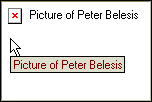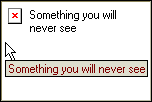DHTML Lab - DHTML Diner - IE4: Toggling TITLE Value Display
|
This is an Internet Explorer 4 technique. The in-page examples will only work in Explorer 4 Windows and Explorer 4 Macintosh. This technique was developed for use in the Hierarchical Menus, Version 3, DHTML Dynomat tool. |
Toggling the Display of TITLE ValuesBackgroundThe ALT= Attribute <IMG SRC="nonexistent.gif" WIDTH=150 HEIGHT=100 BORDER=1 ALT="Picture of Peter Belesis"> The ALT= attribute should describe the missing image. In this way, users with non-graphical browsers or with image display turned off and users using speech synthesizers can still be aware of the page layout and display. The ALT= Attribute as Tool Tip <IMG SRC="../diner.gif" WIDTH=150 HEIGHT=71 BORDER=0 ALIGN=LEFT HSPACE=30 ALT="DHTML Lab Diner Logo"> <IMG SRC="nonexistent.gif" WIDTH=150 HEIGHT=100 BORDER=1 ALT="Picture of Peter Belesis"> You should have seen tooltips like these:
In other words, you saw tool tips that alerted you to nothing that you didn't already know. The ALT= attribute as tool tip is redundant and intrusive. In order for the ALT= attribute to display "meaningful" tooltips, its value must be "advisory" and not "descriptive." It must provide additional useful information related to the tag, or instructions, or the like. For example (pass your mouse over images): <IMG SRC="../diner.gif" WIDTH=150 HEIGHT=71 BORDER=0 ALIGN=LEFT HSPACE=30 ALT="Click to return to Diner front page"> <IMG SRC="nonexistent.gif" WIDTH=150 HEIGHT=100 BORDER=1 ALT="Something you will never see"> The above examples give these results:
In the first case, the tooltip is useful, since we see the image and are provided with additional information. In the second case, where no image is displayed, the tooltip is confusing, since it only makes sense if an image is displayed. Verdict: Explorer introduced an enhancement to the ALT= attribute that is only useful if we do not use the ALT= attribute as intended. Navigator 4 also adopted this behavior for ALT=, although it is "sticky" (doesn't always work). The Standard
Therefore, ALT= has now been expanded to be used with INPUT and APPLET (not yet implemented by any browser) and should only include alternate descriptive text! Using ALT= for tooltips after you have been using it for description is like destroying an already-built wheelchair ramp, thus hampering access that already existed. For those of us who love tooltips, HTML4 introduces the TITLE= attribute. |
Produced by Peter Belesis and
All Rights Reserved. Legal Notices.Created: Sept 14, 1998
Revised: Sept 14, 1998
URL: https://www.webreference.com/dhtml/diner/titletog/






 Find a programming school near you
Find a programming school near you